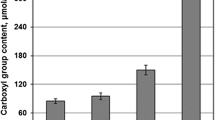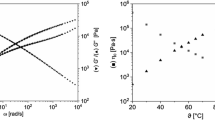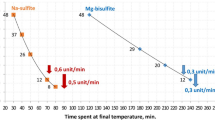Abstract
Textile filaments were fabricated from a solution obtained from carboxymethylated cellulose dissolved in aqueous NaOH solution, by wet spinning in an acid coagulation bath. Spinning is possible for modified cellulose with a carboxyl group content of at least 1.3 mmol/g cellulose. A post-treatment—heating in the presence of sodium hypophosphite—improved the properties of these filaments. This is a novel process, much more environmentally friendly than the viscose process for the production of rayon, in which most of the chemicals can be reused making it likely that the process is economically viable. After extrusion in an acid bath, filaments containing 1.3 mmol –COOH/g cellulose could be washed with water quite readily, a process very difficult for filaments with carboxyl group content of 1.5–1.7 mmol/g cellulose. The tenacity of the filaments obtained from the modified cellulose with a carboxyl group content of 1.3 mmol/g cellulose was 1.0 cN/dtex, which was higher than that of the filaments with carboxyl group contents of 1.5 mmol/g cellulose (tenacity 0.93 cN/dtex) and 1.7 mmol/g cellulose (tenacity 0.88 cN/dtex). The water absorbency of the filaments made from the modified cellulose with carboxyl group content of 1.3 mmol/g cellulose was 0.54 g water/g filaments which was ~ 2 times and ~ 3.5 times lower than that of the filaments with carboxyl group contents of 1.5 mmol/g cellulose and 1.7 mmol/g cellulose, respectively. The values of tenacity and water absorbency for filaments with 1.3 mmol/g cellulose are extremely promising for textile applications.
Graphical abstract











Similar content being viewed by others
References
Alam MN, Christopher LP (2017) A novel, cost-effective and eco-friendly method for preparation of textile fibers from cellulosic pulps. Carbohydrate Polym 173:253–258
Alam MN, Islam MS, Christopher LP (2019) Sustainable production of cellulose-based hydrogels with superb absorbing potential in physiological saline. ACS Omega 4(5):9419–9426
Alam MN, Islam MS, van de Ven TGM, Lumb, J-P (2020) Cellulose-based filaments and methods of production thereof. USPTO 2504, April 2020
Cai J, Zhang L (2005) Rapid dissolution of cellulose in LiOH/urea and NaOH/urea aqueous solutions. Macromol Biosci 5(6):539–548
Carmichael A (2015) Man-made fibers continue to grow. Textile World Innovation Forum 165(1):20
Casaburi A, Rojo UM, Cerrutti P, Vazquez A, Foresti ML (2018) Carboxymethyl cellulose with tailored degree of substitution obtained from bacterial cellulose. Food Hydrocolloids 75:147–156
Chaiyasat A, Jearanai S, Christopherc LP, Alam MN (2019) Novel superabsorbent materials from bacterial cellulose. Polym Int 68:102–109
Chen Z, Burger C, Wan F, Zhang J, Rong L, Hsiao BS, Chu B, Cai J, Zhang L (2007) Structure study of cellulose fibers wet-spun from environmentally friendly NaOH/urea aqueous solutions. Biomacromol 8(6):1918–1926
Chen Y-L, Zhang X, You T-T, Feng X (2019) Deep eutectic solvents (DESs) for cellulose dissolution: a mini-review. Cellulose 26:205–213
El Seoud OA, Koschella A, Fidale LC, Dorn S, Heinze T (2007) Applications of ionic liquids in carbohydrate chemistry: a window of opportunities. Biomacromol 8(9):2629–2647
Fiome MZ (1998) Final report on the safety assessment of glycolic acid and other compounds. Int J Toxicology 17:1–241
Fushimi F, Watanabe T, Hiyoshi T (1996) Role of interfacial potential in coagulation of cuprammonium cellulose solution. J Appl Polym Sci 59:15–21
Global Rayon Fibers Market (2014) TechNavio market research report December 24, SKU: IRTNTR4944
Hummel M, Michud A, Tanttu M, Asaadi S, Ma Y, Hauru LKJ, Parviainen A, King AWT, Kilpeläinen I, Sixta H (2016) Ionic liquids for the production of man-made cellulosic fibers: opportunities and challenges. Cell Chem Prop Fibers Nanocell Adv Mater 271:133–168
Huque QMI, Islam R, Islam MM, Rashid TU, Afrin S, Asaduzzaman Mustafa MAI, Rahman MM, Khan MA (2012) Preparation of rayon fiber-reinforced polypropylene composites by extrusion techniques. Polym-Plast Technol Eng 51:116–121
Ingildeev D, Effenberger F, Bredereck K, Hermanutz F (2013) Comparison of direct solvents for regenerated cellulosic fibers via the lyocell process and by means of ionic liquids. J Appl Polym Sci 128(6):4141–4150
Laszkiewicz B, Wcislo P, Cuculo JA (1992) Fibers made from concentrated viscose solutions. J Appl Polym Sci 46(3):445–448
Li W, Chang S, Chen X, Qi X, Sun H-B (2014) Hydrolysis kinetics of chloroacetic acid with sodium hydroxide under strong alkaline conditions. Asian J Chem 26(11):3404–3406
Liu Z, Wang H, Li Z (2011) Characterization of the regenerated cellulose films in ionic liquids and rheological properties of the solutions. Mater Chemi Phys 128(1–2):220–227
Moradian M, Islam MS, van de Ven TGM (2021) Insoluble regenerated cellulose films made from mildly carboxylated dissolving and Kraft pulps. Ind Eng Chem Res 60(15):5385–5393
Morton WE, Hearle JWS (2008) Physical properties of textile fibers, 4th edn. Woodhead Publishing Limited and CRC Press LLC., Boca Raton, FL, USA
Mundsinger K, Muller A, Beyer R, Hermanutz F (2015) Multifilament cellulose/chitin blend yarn spun from ionic liquids. Carbohydrate Polym 131:34–40
Philipp B (1993) Organic solvents for cellulose as a biodegradable polymer and their applicability for cellulose spinning and dervatization. J Macromol Sci Pure Appl Chemi A 30:703–714
Rogers RD, Seddon KR (2003) Ionic liquids—solvents of the future. Sci 302(5646):792–793
Sabzalian Z, Alam MN, van de Ven TGM (2014) Hydrophobization and characterization of internally crosslink-reinforced cellulose fibers. Cellulose 21:1381–1393
Sayyed AJ, Gupta D, Deshmukh NA, Mohite LV, Pinjari DV (2020) Influence of intensified cellulose dissolution process on spinning and properties of lyocell fibres. Chem Eng Process Process Intens 155:108063
Sherif MA, Keshk S (2008) Homogenous reactions of cellulose from different natural sources. Carbohydrate Polym 74:942–945
Yang H, Tejado A, Alam MN, Antal M, van de Ven TGM (2012) Films prepared from electrosterically stabilized nanocrystalline cellulose. Langmuir 28:7834–7842
Yang G, Yang Y, Zhang H, Shao H (2021) Influences of stabilizers on lyocell spinning dope and fiber properties. Polymer Testing 99:107228
Acknowledgments
The authors want to acknowledge financial support of a NSERC Strategic Project Grant (506303-17) and the industrial partner FPInnovations. Also support of the McGill Fessenden Professorship Award is gratefully acknowledged.
Author information
Authors and Affiliations
Corresponding author
Ethics declarations
Conflict of interest
The authors declare no conflict of interest.
Additional information
Publisher's Note
Springer Nature remains neutral with regard to jurisdictional claims in published maps and institutional affiliations.
Rights and permissions
About this article
Cite this article
Islam, M.S., Alam, M.N. & van de Ven, T.G.M. Production of textile filaments from carboxymethylated cellulosic pulps. Cellulose 28, 9475–9488 (2021). https://doi.org/10.1007/s10570-021-04073-5
Received:
Accepted:
Published:
Issue Date:
DOI: https://doi.org/10.1007/s10570-021-04073-5




